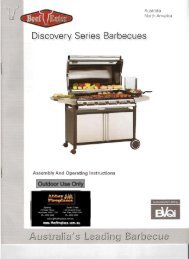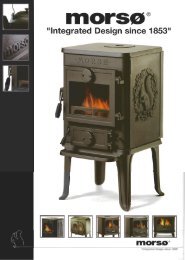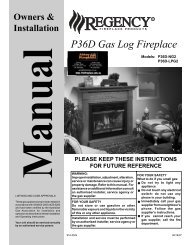Australia's Leading Barbecue - BeefEater Barbecues UK
Australia's Leading Barbecue - BeefEater Barbecues UK
Australia's Leading Barbecue - BeefEater Barbecues UK
Create successful ePaper yourself
Turn your PDF publications into a flip-book with our unique Google optimized e-Paper software.
4<br />
Gas Cylinder Information<br />
Beefeater <strong>Barbecue</strong>s<br />
Gas Cylinder Safety Information<br />
This appliance is designed to be used with a gas<br />
cylinder not exceeding 9KG (20lbs) capacity.<br />
The Gas cylinder must be constructed and marked in<br />
accordance with specifications for LP Gas Cylinders<br />
of the:(USA) U.S. Dept. of Transportation (DOT) or<br />
the National Standard of Canada, CAN/CSA - B339,<br />
Cylinders, Spheres or Tubes for the transportation of<br />
dangerous goods.<br />
The gas cylinder supply valve must be turned off when<br />
the appliance is not in use.<br />
Gas cylinders must be stored outdoors, out of reach of<br />
children and must not be stored in a building, garage or<br />
any other enclosed area.<br />
The gas cylinder used must incorporate a safety collar<br />
to protect the valve assembly.<br />
Important:<br />
When disconnecting and removing the gas cylinder for<br />
the purpose of refilling, always observe the following<br />
procedure.<br />
Ensure that all gas control valves on the appliance and<br />
the gas cylinder are turned off before disconnecting the<br />
gas line from the cylinder.<br />
Do not smoke or use a naked flame near the appliance<br />
or gas cylinder while disconnecting the gas line<br />
between the appliance and gas cylinder.<br />
Remove the gas cylinder from the enclosure before<br />
disconnecting the gas line from the appliance.<br />
Tighten all connections before placing the gas cylinder<br />
back in its enclosure.<br />
The Gas Leak Testing Procedure should be conducted<br />
every time the gas cylinder is refilled and reconnected<br />
to the appliance - before using the appliance.<br />
Regulator Connection (Fig 1 & 2)<br />
1. Check that all control knobs are in the ‘Off’ position.<br />
2. Make sure the cylinder valve is off by turning the<br />
valve knob clockwise.<br />
3. Remove the protective cap from the cylinder if<br />
present.<br />
4. Leak test the connection with a soapy water<br />
solution. (See Gas Leak Testing Procedure)<br />
Hose and regulator replacement must be a<br />
genuine part specified for this appliance and is<br />
obtainable from your nearest <strong>BeefEater</strong> stockist.<br />
Gas Leak Test Procedure<br />
Use the following procedure to check for gas<br />
leaks.<br />
Never use a naked flame to check for gas leaks.<br />
Standard POL Regulator<br />
Fig 1<br />
Tighten in this direction<br />
Regulator and hose<br />
Protector cap<br />
Quick Connect Regulator<br />
Fig 2<br />
Tighten in this direction<br />
Regulator and hose<br />
Protector cap<br />
Gas Shutoff Valve<br />
Bleeder valve screw<br />
Gas Cylinder<br />
Gas Shutoff Valve<br />
Bleeder valve screw<br />
Gas Cylinder<br />
1. In a small container, mix up a solution of water and<br />
detergent or soap. Mix the solution well.<br />
2. For LPG make sure that the gas supply valve on the gas<br />
cylinder is turned on. For Natural gas make sure that the<br />
gas line is correctly fitted to the appliance.<br />
3. Make sure that the gas control valves on the appliance are<br />
all turned off.<br />
4. Using a brush or spray bottle apply the solution to the gas<br />
line and each join in the gas line. See Fig 3.<br />
5. Bubbling of the solution will indicate that there is a leak<br />
present.<br />
6. Re-tighten or re-seal any joints that are leaking.<br />
7. If a leak persists then contact your distributor or the<br />
manufacturer for assistance.<br />
Fig 3<br />
Australia’s <strong>Leading</strong> <strong>Barbecue</strong>
















